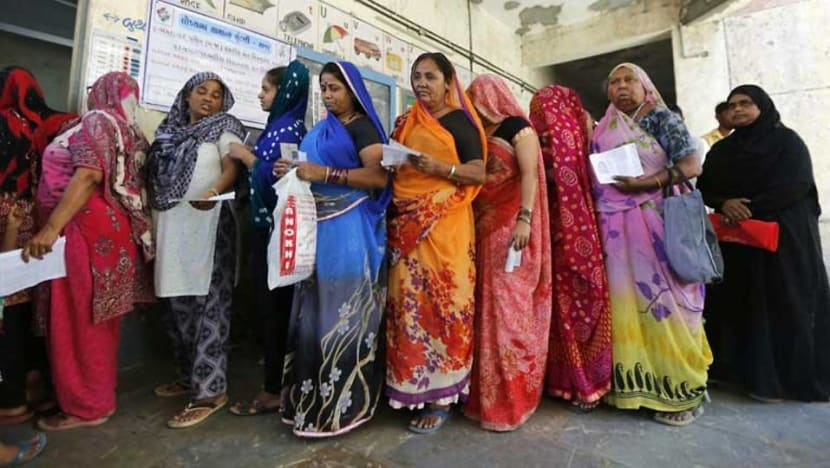From homemakers to kingmakers: Battle to win over India's women voters in the world's biggest election
Observers said the country’s economic and political future is now inextricably linked to its women.

Indian women stand in queue to cast their vote for general election in Ahmadabad. (Photo: AP/Ajit Solanki)

This audio is generated by an AI tool.
INDIA: The battle for India’s women voters is shaping up to be a big and bitter one in the world's largest election, as they form a crucial vote bank that political parties cannot ignore.
Observers said this is a clear sign that the country’s economic and political future is now inextricably linked to its female population.
India is in the midst of a mammoth general election spread over six weeks, with Prime Minister Narendra Modi widely expected to secure a rare third term in power.
EMPOWERING WOMEN
Recent data suggests there is increased political mobilisation among women in the world's most populous country.
More women than men cast their vote at the last election in 2019 for the first time, according to the Election Commission of India.
In this election, nearly a billion people are eligible to vote. There are 471 million eligible female voters, compared with 497 million male voters.
Of the 28 Indian states, 12 have more female voters than male ones.
However, the Modi government’s women-led development narrative has been complicated by the country’s declining female workforce participation.
His Bharatiya Janata Party (BJP) is attempting to prove that it has done more than its share to improve the lives of women in India.
The BJP-led government has rolled out various measures, such as increasing maternity leave from 12 weeks to 26 weeks, to make it easier for women to participate in the economy.
In its manifesto, the ruling party highlighted how it helped 10 million rural women become “lakhpatis”, a colloquial term for millionaires. Mr Modi has promised to raise that number to 30 million if he is elected again.
Within the homes, the government has provided more than 100 million poor women with free cooking gas connections, and has vowed to expand the scheme. It has also built toilets to improve access for over 110 million women, and run positive campaigns to educate and protect girls.
UNDERLYING PATRIARCHAL CULTURE
Yet, the image of a fairer and more equitable Indian society is often challenged by shocking incidents reflecting the country’s deep-rooted patriarchy.
Various politicians across party lines have been accused of sexual assault.
In one incident last year, India’s female Olympic wrestlers accused the then-wrestling federation president Brij Bhushan Sharan Singh, a BJP Member of Parliament, of sexual assault. But their pleas for action have allegedly fallen on deaf ears.
Police detained the athletes during their attempt to march towards the new parliament building while Mr Modi was inaugurating it last May.
Observers said that in Indian elections, women issues seem to get less attention than religion, temple politics and minorities.
But Ms Vanathi Srinivasan, president of the BJP’s women’s wing, said Mr Modi has forced some change and turned the attention to Indian women.
“After BJP came to power in 2014, every political party is very keen on attracting the women voters,” she added.
“So now, slowly the political parties are moving towards the women electorate … who have not been given the proper attention. It is an ongoing process.”
Psephologist Yashwant Deshmukh, founder and director of polling agency Centre for Voting Opinion and Trends in Election Research, said that politicians are “going all out” to get the female vote by “announcing one scheme after the other”.
“Law and order, harassment, rape - all these are becoming huge issues now,” he added.
“Even though the issues which are directly related to the female vote are not being talked about much in the media, as far as politicians are concerned, I think they are very clear that this is the biggest vote bank they need to address.”
FIGHTING FOR EQUAL REPRESENTATION
In recent times, several elections in different states, including the most populated state of Uttar Pradesh, have proven how well-delivered women-specific schemes can be game changers, said Mr Deshmukh.
“Female voters are way more sensible. They do not just look into what has been promised. They also look into how it has been executed,” he added.
Changes are now occurring in terms of equal representation.
In 2022, tribal leader Droupadi Murmu was elected as India’s president, making her the second woman to hold the post.
Last year, Mr Modi’s BJP party also passed a historic Women's Reservation Bill, which would allocate a third of the seats in India's lower house and state assemblies to women.
While he has vowed to implement this during the next five-year term, the opposition Congress Party promised to do it immediately.
Congress leader Rahul Gandhi - who is the grandson of India's first and only woman prime minister so far, Indira Gandhi - expressed his support for the Bill, saying: “We will do it the moment we come to power.”















